Pinellas County is your community. It is where you have chosen to live or work or visit. Taking advantage of its beautiful sunrises and sunsets, urban settings, and natural resources, it is a place where nearly a million people have chosen to make their home, and millions more choose to explore annually. As the County’s permanent population continues to grow, it is projected to increase to over a million residents by 2045.
To be a thriving, resilient, quality community within a sustainable economic environment, Pinellas must offer quality housing, transportation, jobs, infrastructure and public services. The built environment must meet your needs while also protecting the county’s valuable natural resources and mitigating hazards. To ensure these needs are met, the County has developed the policies that guide decision-making and has incorporated them within this Comprehensive Plan, PLANPinellas.
PLANPinellas sets the foundation for addressing the many challenges that Pinellas County is facing. The County has shifted from predominantly “greenfield”, or new development on vacant property, to that of redevelopment. As a coastal community, the County must address sea level rise and the potential impacts of hurricanes and other natural disasters. Shifts in the needs and desires of the population define transportation needs, the types of housing and jobs that need to be provided, and the extent of services that must support the community.
The County is also committed to a series of initiatives that strive to address health and equity for everyone. The intent is to frame the comprehensive plans’ policies to improve your health, including those who may traditionally face health inequities. There are a series of social determinants of health, or those conditions in the environments where people are born, live, learn, work, play, worship, and age that affect a wide range of health, functioning, and quality of-life outcomes and risks. These determinants include such things as: housing and neighborhoods; public safety; water and sanitation; the natural and built environments; transportation; economic development; and community context. Each of these factors are addressed in the comprehensive plan, with an emphasis on access for all, to options that meet your needs.
PLANPinellas addresses the County’s evolving needs and supports the thriving future envisioned. It acts as the guide by which the community’s development and conservation decisions are made, covering a wide range of topics, such as: land use, mobility, natural resource protection, and public services; all intended to improve your quality-of-life.
state requirements.
In Florida, the Department of Economic Opportunity (DEO) oversees local government comprehensive planning.
The County’s previous Comprehensive Plan (‘Planning to Stay’) was adopted in 2008. That Plan was the result of Florida’s Growth Management regulations that were in place at that time, known as Florida Administrative Code Rule 9J.5. That Rule established requirements for a community to have a comprehensive plan in place that allowed for limited local flexibility, as overseen by the State’s Department of Community Affairs (DCA). The State has since reorganized the DCA and established a new Department of Economic Opportunity (DEO), which now oversees local government comprehensive planning. Rule 9J.5 was repealed by the State in 2011 and replaced by amended Chapter 163 F.S. Intergovernmental Programs; and specifically, §163.3177 required and optional elements of comprehensive plan; studies and surveys. While this section continues to outline specific element (or chapter) topics that must be included in a comprehensive plan, the local government is afforded more control over the creation and evaluation of their community’s comprehensive plan. Chapter 163 F.S. Intergovernmental Programs, and more specifically §163.3177 outline the requirements of a comprehensive plan. Additionally, Forward Pinellas serves as the County’s overarching transportation and land use planning agency, establishing policies through its Countywide Plan, by which each of the municipalities and the unincorporated area must coordinate their individual comprehensive plans.
local requirements and guidance.
Forward Pinellas serves as the County’s overarching land use and transportation planning agency. Their Countywide Plan establishes policies by which each of the municipalities and the unincorporated area must coordinate their individual comprehensive plans. Advantage Pinellas server as the county’s long range transportation plan and guides coordination of the area’s transportation network among the local jurisdictions.
In 2017, the County embarked on a multiphased process to identify what needed to be updated in the Comprehensive Plan. That process included three major phases: 1) Policy Consolidation; 2) Guiding Principles; and 3) Evaluation and Revision.


This exercise enhanced the effectiveness of the existing policies by establishing a clearer understanding of their meaning. The result was significant because it created a stronger base from which the County’s policies were assessed for update.
In order to more clearly define the County’s vision and guide the evaluation and revision process to follow, eight Guiding Principles were drafted (focusing the previous 47 Governing Principles). These Principles were coordinated with each of the County’s departments, presented to the Board of County Commissioners, and shared with the community at-large. Each of these stakeholder groups expressed their support of the vision as defined by the Guiding Principles.

public participation.
PLANPinellas and its Guiding Principles establish the community’s vision. It lays the foundation for the County’s decision-making over the next decade and into the future; addressing opportunities for growth, the delivery of public services, and the sustainability of our local economy and ecosystem. It was important that the public at-large be part of the process, with opportunities to share their feedback as the document and underlying principles were crafted and finalized.
With the introduction of the Guiding Principles, the community showed their support for the County’s direction towards a balanced, resilient community. The community was informed, and feedback was gained through open houses around the county, online survey questions, community informational events, project videos and flyers, and the creation of a project webpage. Conversations were held with the County’s Youth Advisory Committee and local community groups.
The public outreach effort was reintroduced with draft revised goals, objectives, policies and strategies. PLANPinellas was shared with the public through an enhanced comprehensive plan webpage, webinars and presentations, and a continued comment/response process. On-going implementation of PLANPinellas remains a process that the community can be a part of through identified Everyday Actions, participation in public events and continued conversations to address community needs.
Pinellas County is a major urban county with close to a million permanent residents, with an additional influx of 12 to 15 million visitors annually. This massive population is accommodated all within just 273 square miles of land, located on a peninsula. In terms of land area, the County represents only 11 percent of the total land in Tampa-St. Petersburg-Clearwater Metropolitan area. However, despite its small geographical size, Pinellas County is the sixth most populous and the densest county within the State of Florida.
Pinellas County saw most of its growth in the decades that followed Word War II. After seeing a period of phenomenal growth and urban expansion, today the county is mostly built out. Comprising of 24 municipalities, several old and newly established neighborhoods, and characterized by a diversity of urban and suburban environments, the county has limited vacant land for new growth. Most of the vacant land that is currently available for development are smaller, irregular tracts of land under separate ownership, that are distributed throughout its urban environment. This has created considerable challenges for accommodating new growth or for providing new housing and employment opportunities within the county. This has also inevitably, resulted in a shift in focus towards redevelopment and infill-development in recent years. While some areas such as the Gateway Area and Lealman (see Pinellas County map on the following page), continue to show great potential for new growth or redevelopment, overall, there has been a low rate of residential development in the county since 2015. (Source: Pinellas County Local Mitigation Strategy, 2020) The population in Unincorporated County has been declining in past years and this trend is projected to continue through 2040. A growing trend of annexations – where previously unincorporated land has been acquired by municipal (incorporated) areas of the county – has contributed to this decline.
Despite this slow down, the total County’s population has been slowly yet steadily increasing. Between 2015 and 2018, Pinellas has grown by approximately 60,790 residents, reaching a population of 975,280. By 2045, the total population is expected to exceed one million. With more than 400,000 households calling Pinellas County their home, it is evident remains a desirable location to live and work. In fact, the population in Unincorporated County has been declining in past years and this trend is projected to continue through 2040.

When envisioning the future, it is imperative to understand today’s conditions. What assets and opportunities exist for our community to build upon? What challenges must be addressed in order to achieve the overall vision? Who is being served and what are their needs? The following is a summary of Pinellas’ key assets, challenges, and demographic trends
assets.
COASTAL RESOURCES
Pinellas County has approximately 39 miles of coastline along the Gulf of Mexico, much of which provides public access to beaches. Several are recognized for being some of the top beaches in the United States. The coastline plays an important role in Pinellas County, significantly contributing not only to tourism and the economy, but to the overall quality-of-life for its residents and visitors.
PARKS AND NATURAL RESOURCES
Pinellas County maintains over 20,000 acres of parks and preserves that provide recreational opportunities for residents throughout the County. These lands offer a range of experiences providing different functions and amenities across the system. Parks offer opportunities for both passive and active use (e.g., shelters; playgrounds; boat ramps; beaches; dog parks; trails; etc.). Preserves have a primary function to conserve land and protect our natural resources, and also provide recreational assets. The County maintains four preserves with opportunities for fishing, hiking and kayaking. Each of Pinellas’ parks and preserves offer unique views and experiences and offer users the opportunity to interact with each other and with nature.
TOURISM
Pinellas County is a major tourist destination, hosting as many as 15 visitors annually, who are attracted to the tropical climate and coastal atmosphere. Vacationers and day-trippers generate significant visitor spending inside the County. There are a wide range of opportunities to experience art and culture at the many museums and theaters located around the County. A wide range of dining and shopping offer additional entertainment options.
ECONOMY
The County’s economy benefits from proximity to several major transportation resources including I-275 and St. Pete-Clearwater International Airport, located within the County; and I-4, the Port of Tampa, and Tampa International Airport, outside of Pinellas. These amenities connect the County to major regional and national industry nodes and provide multiple travel options for businesses.
Pinellas has the third largest base of manufacturing employment in Florida, with prominent Fortune 500 technology manufacturers headquartered here. Pinellas has diverse, yet symbiotic, industry clusters, including aviation/aerospace; defense/national security; medical technologies; business and financial services; and information technology. An extensive network of suppliers, service-providers and business associations support operations in these sectors. Pinellas is rapidly becoming Florida’s hub for big data, with industry giants locating here. Through relationships with major universities and high-tech institutes, Pinellas has become a center for research and development in marine science, electronic instruments, medical devices, sensors, nanotechnology and health care. The County is also home to numerous business accelerators.
challenges.
REDEVELOPMENT
Pinellas County, being the densest county in Florida, has experienced the peak of its potential for new development, and now focuses on redevelopment. This shift poses a unique challenge as it is impacted by such things as: the need to address vertical development (or building up instead of out); the land, building stock and infrastructure needs of relocating businesses (do we have the right size and age of buildings for reuse); demolition costs vs. the cost of retrofitting; accommodating parking needs for different uses of the same space; and ensuring we offer the types of neighborhoods and necessary amenities that a modern workforce demands.
MOBILITY
Mobility, or how people move between destinations, is a significant issue. The County benefits from a gridded network of streets, providing multiple routes between destinations. However, the roadways tend to promote the needs of automobiles over those of non-drivers. It is important to create a comfortable and convenient environment for pedestrians, cyclists and transit riders. Pinellas serves a large aging population, as well as school-aged children, resulting in a significant population without the option to drive. Congestion is also a concern for many of the County’s roadways, especially during peak times. This situation furthers the need to make sure that safe mobility alternatives exist.
INFRASTRUCTURE
As an established community, Pinellas County has a large built-out infrastructure network that is important to quality-of-life. The continued, and often growing, upkeep and maintenance of these systems (roadways/sidewalks; parks/trails; utilities; etc.) offers specific challenges with increased demand on the system from a growing population, changing technologies for delivery of services, and rising repair costs. The operation and enhancement of the County’s infrastructure require strong coordination and fiscally-responsible decision-making to ensure an effective delivery of services and provision of amenities.
NATURAL HAZARDS
Pinellas County is a peninsula, increasing its vulnerability to natural hazards. Hurricanes and flooding are real threats and potential impacts can be devastating. Our goal is to become a more resilient community, which can be achieved through improving building standards, appropriately locating capital improvement projects to minimize impacts, and educating residents on how to prepare for such events. As a coastal community, sea level rise and vulnerability to increased water levels is a growing threat. The coordination among several of the County’s Departments, including Emergency Management, the Federal Emergency Management Agency, and other State and local partners is essential to prepare for and respond to these events.
vulnerability and resiliency.
Studies indicate that population growth or increase in density and urbanization, can impact a location’s vulnerability. In addition, the geographic distribution of this population growth and the demographic characteristics, can help determine the different levels of risk and vulnerability experienced by different population groups.
Increase in population in turn increases demand on services. Considering the small size of the County; its location on a peninsula with limitations on outward growth; older housing stock and infrastructure; and a high susceptibility to flooding and other hazards; an increase in population, creates considerable challenges for addressing not just emergency operations (such as evacuation and sheltering) but also for long-term mitigation and resiliency.
The County’s population growth and increase in number of structures has resulted in a moderate increase in vulnerability for the whole county and a relatively higher increase in vulnerability for certain areas within the County. For increase in building counts or population specific to each jurisdiction, please refer to the Risk Assessment Tables found within the Appendix of the this chapter.
Also contributing to our vulnerability are the age and condition of the built environment. The coastal environment and the high susceptibility to both inland and coastal flooding further exacerbates this condition. Approximately 88,000 structures in Pinellas County and its municipalities are within the Special Flood Hazard Area. Approximately 55,000 of these structures were built prior to 1975, when federal floodplain regulations had not yet been adopted in most jurisdictions. Some of the older buildings built prior to the adoption of the new stricter construction codes, could be at a greater risk to flood or wind events. While these factors increase risks and vulnerability, Pinellas County’s numerous parks and ecological preserves act as a natural buffer and play a critical role in reducing vulnerability.
CHANGE IN DEMOGRAPHIC CHARACTERISTICS
In addition to population growth since 2015, we have also seen a change in our demographic profile, which could have significant impacts on vulnerability. Some of these trends were visible since 2010 but have become more pronounced in recent years. Pinellas County’s population is aging, and we also continue to attract more retirees. Therefore, in the past decade, we have seen an overall increase in median age. In 2015, 39 percent of our population was 55 years of age or above and 23 percent was 65 years of age or above. This is a trend with significant implications in terms of our vulnerability and is expected to continue. By 2045 it is projected that, almost half of Pinellas County’s population will be 55 years of age or above with 35 percent of the age 65 years or above. In Pinellas County, more than 140,000 households (approximately 35 percent of the total households) have a householder of the age 65 years or above. Elderly population are more likely to have a disability, chronic illnesses or mobility issues which could impede their ability to evacuate. Physical conditions, and limited income and access to resources, can limit their ability to recover following a major disaster.
As of 2017, approximately 45,815 households in Pinellas County comprise of people who are Foreign Born Non-Citizens. This represents 11 percent of total households. Additionally, close to 3 percent of Pinellas County’s households have limited English-speaking proficiency, who may find it difficult to understand emergency warnings which could severely limit their ability to quickly respond in an effective and timely manner. These groups may also have limited knowledge of the available programs. In addition, people with language-barriers may have inadequate access to health care and other resources as compared to regular citizens, which can drastically impair recovery following a major disaster.
Poverty and income levels are other factors that determine one’s vulnerability and capacity to recover from a major catastrophic event. More than 120,000 households in Pinellas County are at or below the poverty level. According to the U.S. Department of Housing and Urban Development, cost-burdened families are defined as those “who pay more than 30 percent of their income for housing” and “may have difficulty affording necessities such as food, clothing, transportation, and medical care.” Severe rent burden is defined as paying more than 50 percent of one’s income on rent. According to the 2017 ACS estimates, more than a quarter of Pinellas County’s households earn less than $50,000 and are cost-burdened or severely cost-burdened. Studies indicate that areas that are economically distressed prior to a disaster, take longer to recover from the aftermath of a disaster. Economically disadvantaged groups most likely occupy lower quality housing, have limited means to pay for flood insurance, and have limited access to warning information, which severely impairs their ability to recover.
According to the Centers for Disease Control and Prevention, certain factors such as sex, age, or income can influence one’s health and risk to diseases, as well as the risk to public health emergencies. This is a critical concern knowing that Pinellas County is highly susceptible to floods and everyone is located within some (high, moderate or low risk) flood zone. Flooding is one of the most common natural hazards in Pinellas County. Flooding poses a serious threat not just in terms of loss of life, personal property, businesses, transportation and utilities, but also to public health. If flooding causes conditions where floodwaters inundate drinking water facilities, wastewater treatment plants, and waste storage facilities or waste disposal sites, it could eventually lead to severe public health emergencies. A good proportion of our population is either old, has limited income or both, which disproportionately increases their risk to impacts flooding impacts. Additionally, due to limited means and inadequate access to resources, such population groups may have limited capacity to deal with the effects of a disaster. This highlights how critical it is to identify these at-risk groups well in advance, devise targeted mitigation efforts that cater to the needs of these specific groups and help plan for potential impacts of a disaster. Some of this research and identification of relevant mitigation actions, will be accomplished as a part of the Post-Disaster Redevelopment Planning process.
The Comprehensive Plan must respond to vulnerability through sustainable land use and development practices and continued protection of our natural resources. As the County’s vulnerability becomes more defined and new solutions and best practices emerge, the policies must respond accordingly.
Community Redevelopment Areas (CRA) is one tool to focus investment and redevelopment strategies to improve infrastructure, and housing and job opportunities for challenged areas. Several communities in Pinellas County have established CRAs, including Lealman CRA in Unincorporated County.
The maps given on the following pages indicate, specific areas that might have high vulnerability within the county owing to different socio-economic factors.
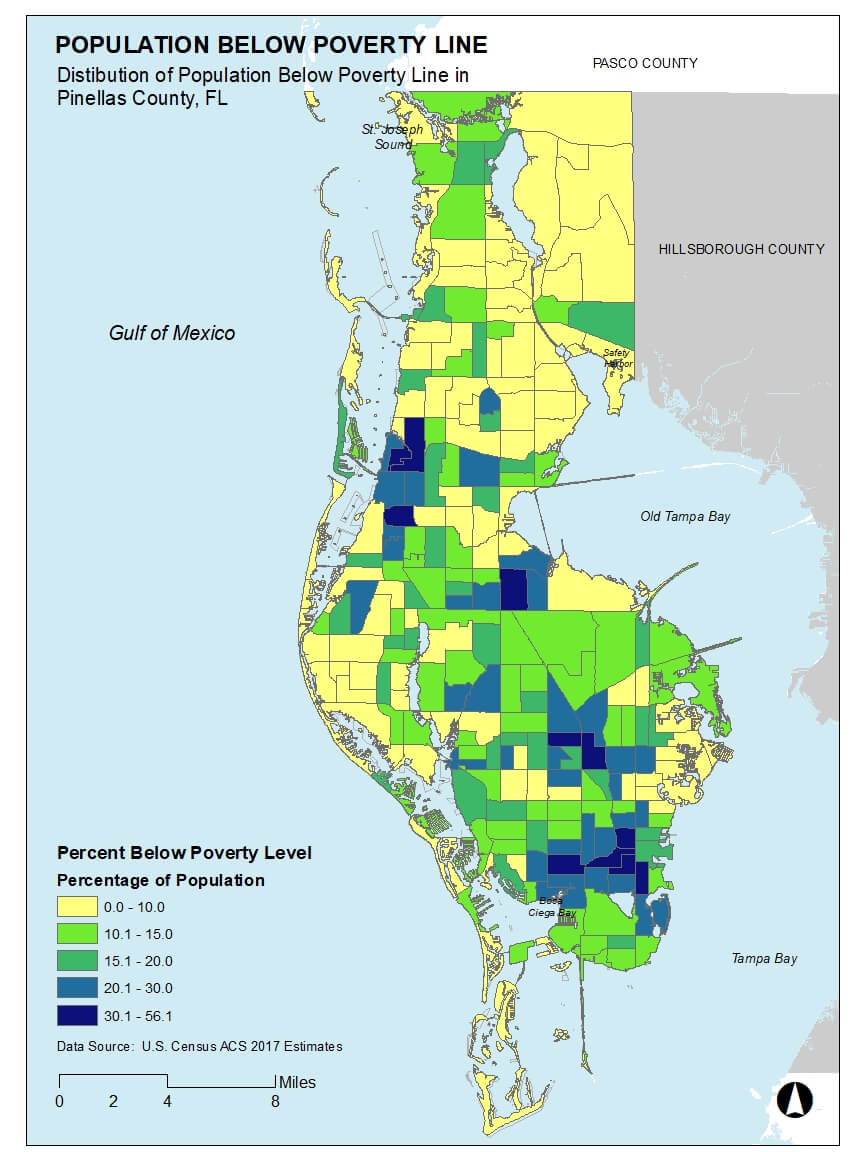

affordable housing and housing affordability.
Essential for the well-being of a community is the availability of safe, quality housing for all its residents. The availability of housing is not enough; the types and costs must meet the needs of the population. And affordability is not just defined by the price of a home. It is impacted by other factors such as access and mobility. Convenient location of residences, or proximity to other resources and amenities, is part of this conversation. Employment opportunities should be proximate to workers’ homes, and residents should be able to afford the commute which is influenced by such things as gas prices and transit fares, and the availability of sidewalks and bike lanes. There should be viable options to get to grocery stores, doctor’s offices, child care services, and other daily needs.
As of 2018, 45% of households were non-family households, and 75% of households were one- two-person households. According to the U.S. Census 2017 5-year estimates, 35% of all County households, and 30% of all County households earning less than $50,000, are cost-burdened and severely cost-burdened, meaning they pay more than who pay more than 30 percent of their income for housing. When you factor in transportation costs those with lower household incomes are impacted to a greater extent, as they have less disposable income to spend on non-housing needs (e.g., transportation; food; health care; education; savings for retirement; etc.)
Often, affordable housing is thought of as very low- , low- and moderate-income households, as defined by the United States Department of Housing and Urban Development (HUD). It is necessary to create a strategy to provide quality housing for this vulnerable population, and general housing affordability for all residents should be addressed for the County at-large. The range of housing types, sizes, and costs should be available and affordable for all. One way these options can be addressed is through the provision of ‘missing middle’ housing, or the range of multi-unit or clustered housing types that are compatible in scale with single-family homes. Other strategies include bonus densities for affordable housing, incentive funding and regulatory reform to reduce barriers for new development.
PLANPinellas puts forth policies that help to address the varying needs across the County by encouraging a range of housing types/sizes and promoting transportation options and mixed-use development patterns. This Comprehensive Plan recognizes the many factors that impact housing affordability.
demographic trends.
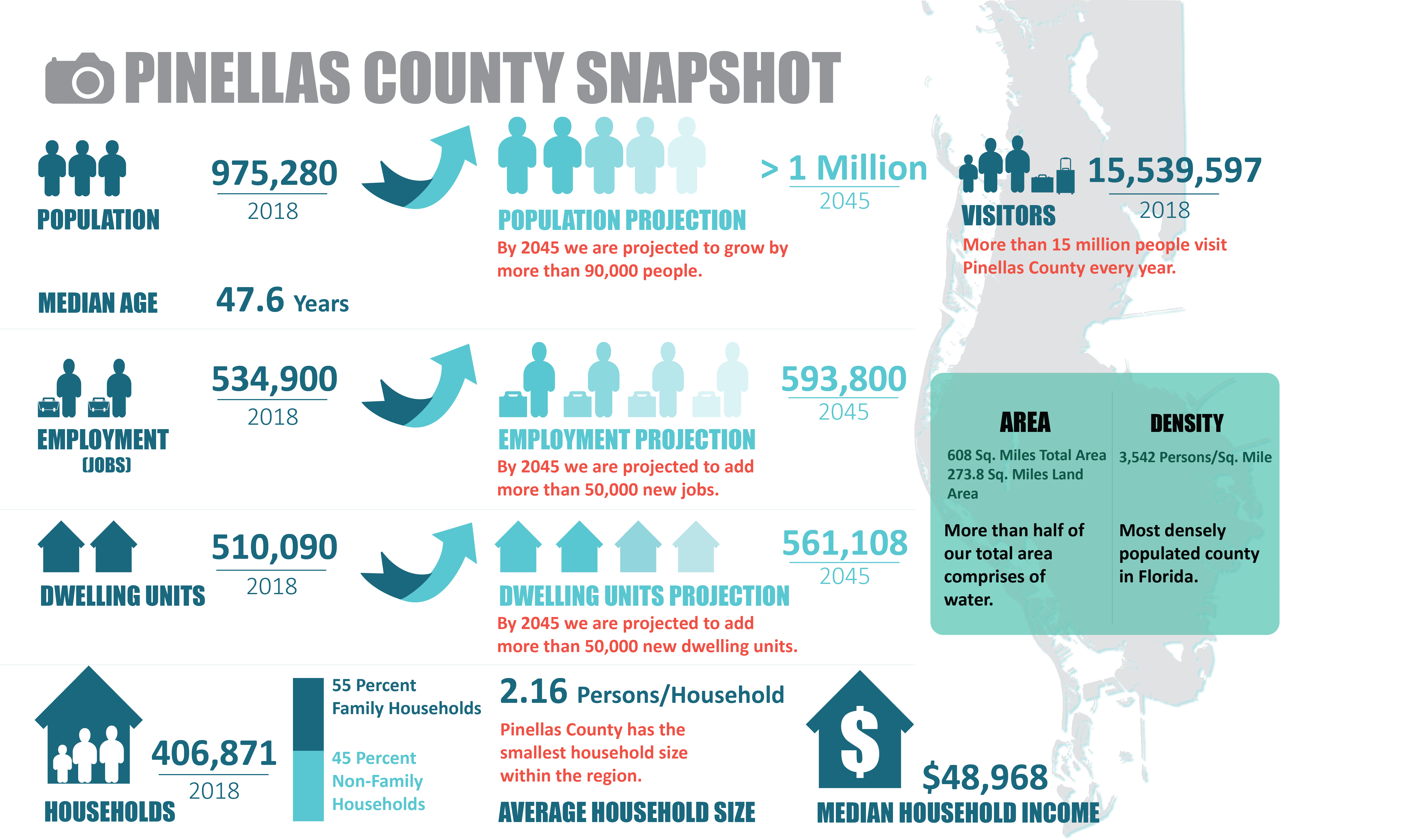

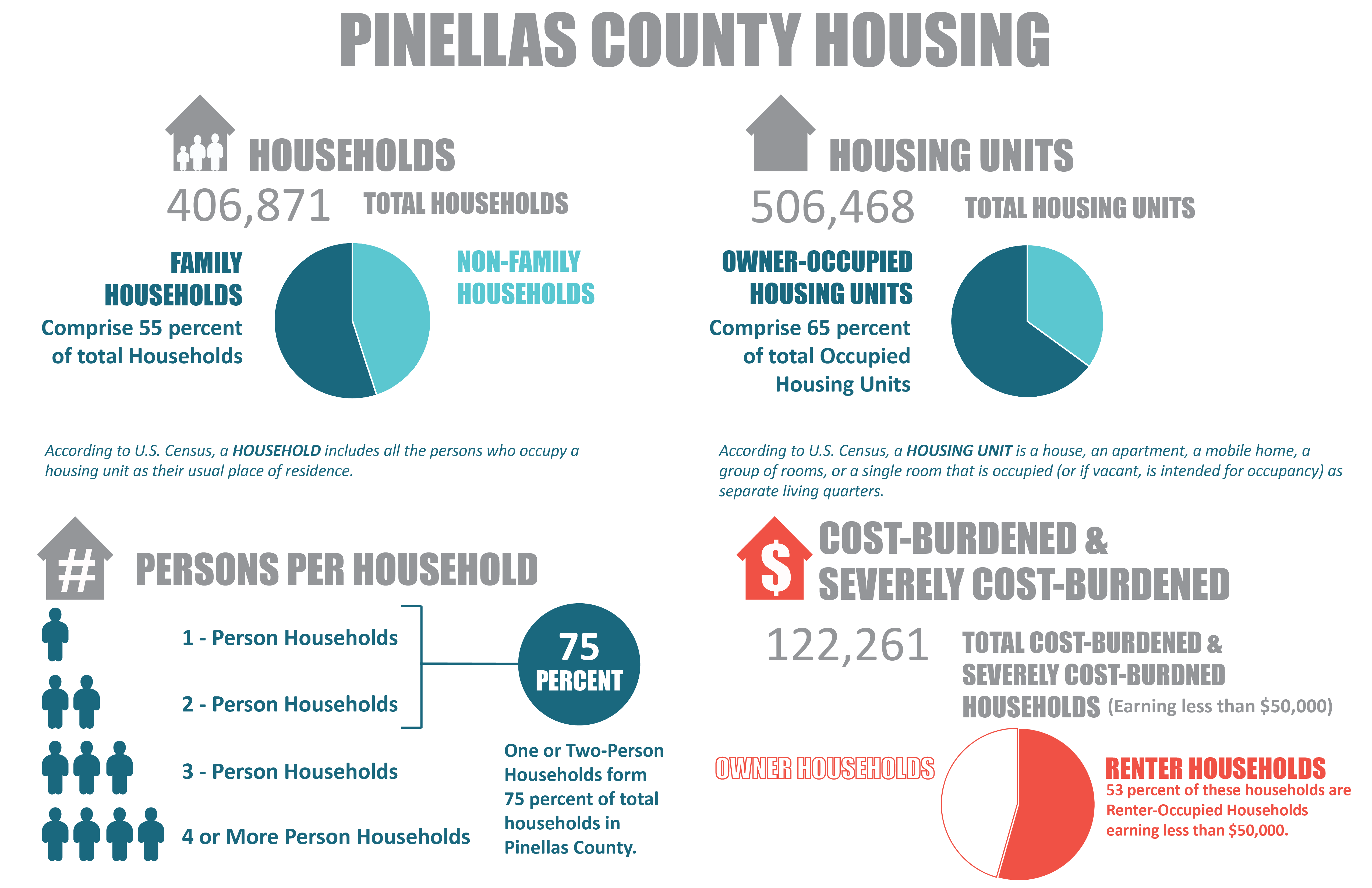

Traditionally, comprehensive plans balance the needs of the built and natural environment. What cannot be lost are the users of that environment – the people. We have a diverse community representing a wide of range of ages and backgrounds; and the needs across our community vary. PLANPinellas reflects this variation and supports equitable access to an improved quality-of-life. Three key perspectives were used to guide policy:

As the Comprehensive Plan serves to support and protect the County’s future, it is imperative to recognize how local policies equitably influence the health of the County and its citizens across all ages.
While individual health focuses on personal medical care, public health addresses those issues that influence the health status of the population. Public health is the science and art of preventing disease, prolonging life, and promoting health through the organized efforts and informed choices of society, organizations, public and private communities, and individuals.
Pinellas County is resource-rich with many high-quality parks, trails, schools, businesses, and healthcare providers that contribute to creating a healthy community. Yet, only approximately 35% of adults are at a healthy weight and 12% of adults self-report poor mental health in Pinellas County. To contend with health issues, we must expand the way we think about health to ensure that all residents have opportunities to make healthy choices.
To address health and equity, Pinellas County joined the Health in All Policies (HiAP) Pinellas County Collaborative upon receipt of a grant from the Florida Department of Health in Pinellas County and the Foundation for a Healthy St. Petersburg in 2018. HiAP is a collaborative approach to improving the health of all people by incorporating health considerations into decision-making across sectors and policy areas.
The HiAP approach focuses on population health and prevention of illness by looking at factors or social determinants of health. Rather than treat an individual after they become ill, HiAP focuses on creating policies that stop illness and poor health outcomes from happening. By proactively addressing the health impacts of all sectors, we can make change that affects population health.
Through collaboration, policy change, and institutional transformation, the HiAP Collaborative aims to make the healthy choice the easy choice for all Pinellas County residents.
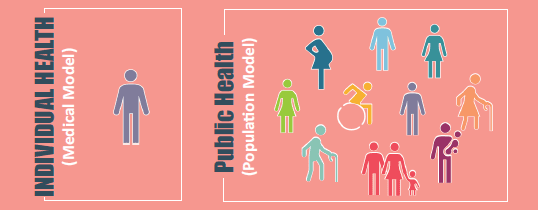
creating health where we live, learn, work, & play.
Health begins outside of the doctor’s office in our homes, schools, and jobs. Where you live affects how well and how long you live. Physical, social, and economic environments in Pinellas County directly influence the health of residents. Your job or neighborhood should not be hazardous to your health. In fact, your neighborhood should provide opportunities to make choices that allow you to live a long, healthy life.
The social determinants of health are the conditions in which people are born, grow, work, live, play, and age.

how healthy is pinellas county?
County Health Rankings illustrate the overall health of counties and provide a comparison of counties within the same state. Two major categories exist for County Health Rankings: health outcomes and health factors. Health outcomes are measures that describe the current health status of a county, including length of life and quality of life.
These health outcomes are influenced by a set of health factors, which include health behaviors, clinical care, socioeconomic factors, and the physical environment. Health factors and their subsequent outcomes may be affected by community-based programs and policies designed to alter their distribution in the community.
Pinellas County ranks 25th out of 67 Florida counties in health outcomes, and 12th out of 67 Florida counties in health factors.

Counties can improve health outcomes by addressing all health factors with effective, evidence-based programs and policies. Pinellas County is addressing many of these factors in our comprehensive plan update, as well as our cross-sector Health in All Policies initiative.
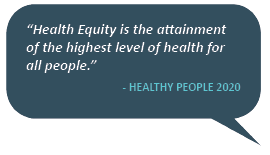
health & equity.
Equity is different than equality. Equity acknowledges that one size does not fit all. For everyone to live a long and healthy life, some people may need more assistance than others.
We all desire good health, but not all Pinellas County residents have the same opportunity to achieve it. Pinellas County residents that live a few streets apart may have drastically different opportunities for jobs, healthcare, education, and other resources. These differences in opportunity and access affect health outcomes, such as how likely we are to get sick or to experience issues with our mental health.
Health Inequalities: differences in health status between different population groups due to genetics, lack of resources, or other factors; typically, unavoidable and may not be feasible to address.
Example: Women are more likely than men to develop breast cancer. This is a difference in health status between men and women that is unavoidable.
Health Inequity: differences in health status that are avoidable or unfair; may be contributed to a difference in the distribution or allocation of resources (e.g., clean air, safe housing, health insurance) between groups.
Example: Infant mortality rates vary significantly by race and ethnicity. Black/African- American babies are more likely to die than White babies throughout the United States, including Pinellas County. In Pinellas, the infant mortality rate is 3.6 infant deaths per 1,000 live births among the White population compared to 11.2 deaths per 1,000 live births among the Black population. These differences in infant mortality are attributable to preventable differences in access to health care and education.

In Pinellas County, many of the leading causes of death – such as heart disease, cancer, and diabetes – are from preventable chronic diseases. Just four behaviors cause much of the illness and early death related to chronic diseases: 1) lack of exercise; 2) poor nutrition; 3) tobacco use; and 4) drinking too much alcohol. Our local government creates policies that shape our environment and influence residents’ health risks and behaviors.
using PLANPinellas to create a healthy pinellas.
To improve health outcomes, we must provide fair opportunities for all residents to make healthy choices through County policies and programs across sectors and policy areas.
The following are just a few examples of how different elements of the comprehensive plan can impact health.
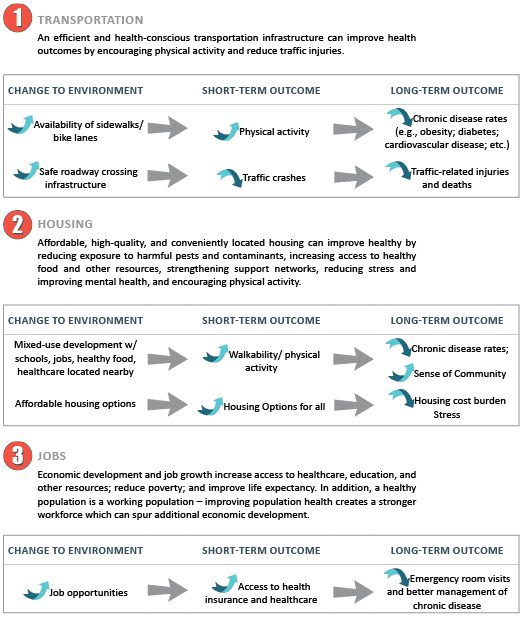
systems focus.
The County is a dynamic system in which each moving part is dependent upon or connected to the other. An example of this interconnection is shown through the following graphic, linking the key issues of jobs, mobility, education, housing, and livability.
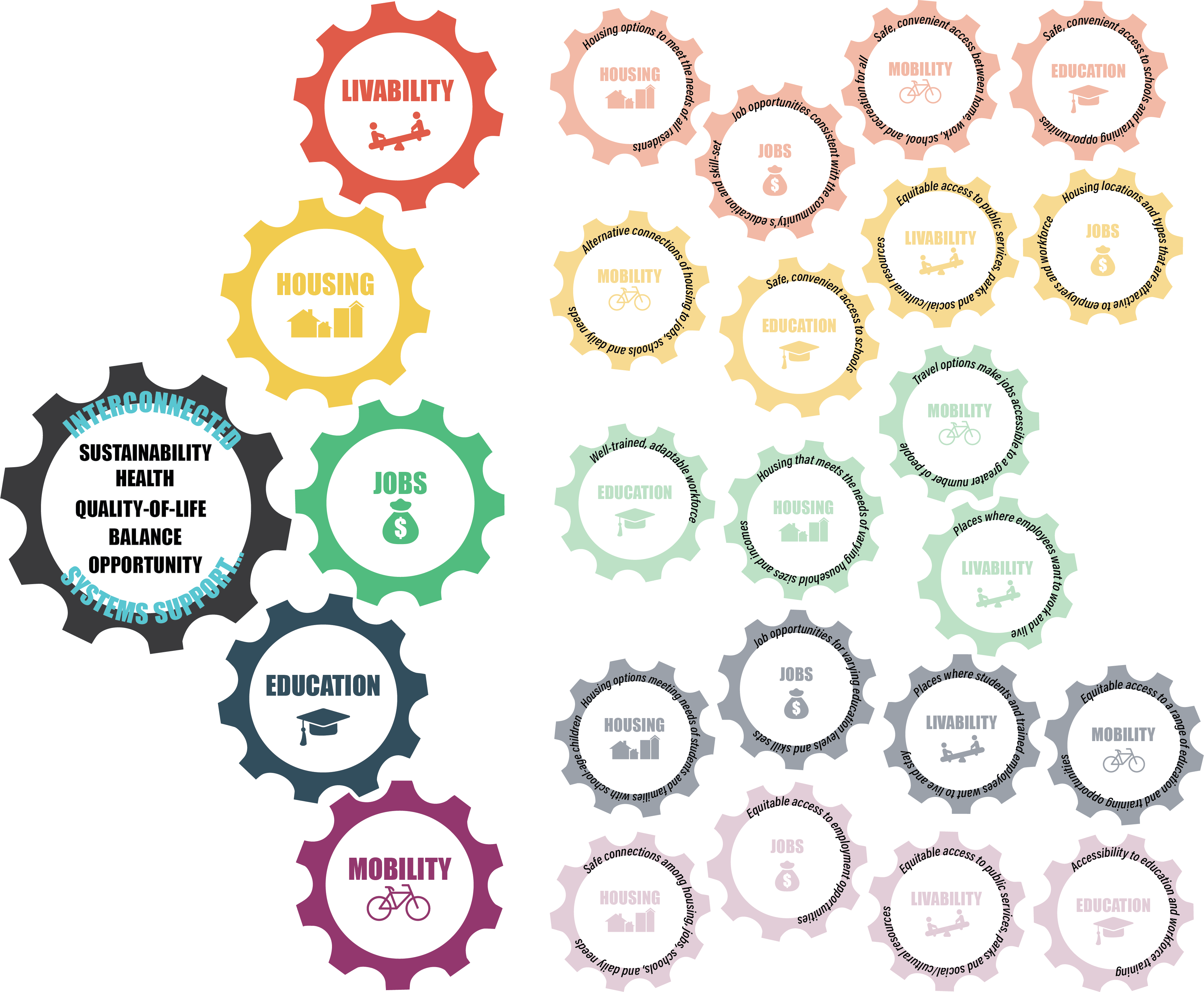
LIVABILITY
The amenities and services a community provides its citizens and visitors defines its livability. Improving residents’ health and quality-of-life, attracting new jobs and enhancing tourism is influenced by a series of factors, such as the efficient delivery or services and the provision of safe, convenient neighborhoods with social, cultural and recreational opportunities. The County’s natural resources support livability by contributing to improved air and water quality; minimizing flooding; ensuring biodiversity; and providing a network of parks, preserves, and aquatic resources.
HOUSING
The range of a community’s housing opportunities directly impacts its residents’ quality-of-life. Housing options influence household spending and the safe and convenient connection to jobs, schools, daily services, and recreation. Choice in housing types, sizes, and costs should meet the needs of all residents.
JOBS
The strength of the local economy is dependent upon the availability of skilled employees. To remain competitive for high-wage jobs the County must maintain a well-trained workforce of adaptable talent. This need demands investment in and coordination with the County’s educational system, from pre-kindergarten, to secondary education, to higher education and workforce training programs.
EDUCATION
Bringing jobs into the County is essential for the resiliency of the local economy and long-term success of the community. The area must support the employment needs of all its citizens by attracting and retaining high-wage jobs. Doing so creates demand for additional businesses and support services, and their associated employment opportunities.
MOBILITY
As a County that serves a diverse population and mix of communities, it is important that the transportation system serve everyone’s needs. It should provide a safe, comfortable and convenient network for all users – motorists; cyclists; pedestrians and transit riders. The design and programming of this system should accommodate the context and community it serves.
To achieve this balanced future for the County we must lay the policy foundation that supports the ways we choose to address our needs. PLANPinellas establishes these policies that support the methods and tools we use to achieve our goals.

Recognizing the interdependence of the many factors that support quality communities is essential for identifying the right tools to use to successfully implement the policies that achieve the County’s goals.
guiding principles.
The intent of a comprehensive plan is to establish the long-term vision for a community and define the policies that help to achieve that vision. PLANPinellas establishes key guiding principles that frame the County’s vision, recognize the interrelationship of the different focus areas, support the needs of the community, and serve as the foundation for the goals, objectives, policies and strategies outlined in the subsequent chapters.

CONSIDER LONG-TERM IMPACTS AND EVALUATE POLICY DECISIONS TO ENSURE THAT THEY SUPPORT A SUSTAINABLE FUTURE.
Sustainability as it relates to policy and development, is a concept by which actions that meet the needs of the present do not compromise the ability of future generations to meet their own needs. Sustainable communities support a balance of economic, social, and environmental resources and practices. They recognize and address the interrelatedness of the economic landscape, transportation network, land use patterns, neighborhoods, natural resources, and the way in which citizens move and interact within that system.

CREATE AND ENHANCE SAFE, HEALTHY COMMUNITIES THAT ATTRACT AND RETAIN A SOCIALLY AND CULTURALLY DIVERSE POPULATION.
Healthy communities ensure that everyone has fair and just opportunity to access the many resources that natural and built environments provide. They offer a range of live, work and play options that enhance quality-of-life. These communities consist of safe neighborhoods with access for all its citizens to a mix of uses; housing options; recreation and transportation options; and employment opportunities. Healthy communities promote a clean environment; support access to fresh food; encourage physical activity and social interaction, and provide access to cultural resources, (e.g., libraries; museums; performing arts centers; cultural heritage recognition and events, etc.) The County’s health, and appeal as a place to live, work, play, and visit is also dependent upon the quality of the services provided (e.g., water; sewer; solid waste / recycling; etc.).

FACILITATE A STRONG LOCAL ECONOMY THAT SUPPORTS SUSTAINABLE, HEALTHY COMMUNITIES AND ENHANCES EMPLOYMENT OPPORTUNITIES AND THE QUALITY-OF-LIFE FOR ITS CITIZENS.

PROVIDE A RANGE OF HOUSING OPTIONS TO MEET THE NEEDS OF A DIVERSE AND INTERGENERATIONAL COMMUNITY.
Housing plays a significant role in a community and significantly impacts quality-of-life. Housing affordability is a growing issue as housing prices and rents rapidly rise in comparison to household income. Housing options influence household spending and the safe and convenient connection to jobs, schools, daily services, and recreation. The availability of well-located housing reduces transportation impacts and improves the environment. Housing options impact economic development opportunities by providing a range of housing types attractive to employers and the workforce. Design and placement of housing should address the needs of the community.

PROVIDE AN INTERCONNECTED, RESILIENT MULTIMODAL TRANSPORTATION NETWORK THAT SAFELY, EFFICIENTLY AND EQUITABLY ADDRESSES THE MOBILITY NEEDS OF ALL CITIZENS, VISITORS AND BUSINESSES, WHILE SIMULTANEOUSLY MINIMIZING OPPORTUNITIES FOR TRAFFIC-RELATED FATALITIES AND INJURIES.
As a County that serves a diverse population and mix of communities, it is important that Pinellas’ transportation system serves everyone’s needs. A viable multimodal system that addresses the needs of pedestrians, cyclists, and transit riders will reduce dependence on the automobile, and provide transportation options to those with different needs. The transportation network should provide a safe, comfortable, and attractive landscape for transit users, pedestrians, cyclists, and drivers; and meet the needs of the County’s multigenerational citizens.

PROTECT THE DIVERSE ECOSYSTEM THAT MAKES UP THE COUNTY’S NATURAL RESOURCES, AND CONTRIBUTES TO THE COUNTY’S PUBLIC HEALTH, QUALITY-OF-LIFE, AND LOCAL ECONOMY.

PROMOTE ADVANCING BEST PRACTICES AND TECHNOLOGIES THAT BENEFIT THE ECONOMY; HEALTHY COMMUNITIES; AND THE PUBLIC HEALTH, SAFETY AND WELFARE.
The County should promote the use of best practices in the respective focus areas, and continuously be aware of emerging trends, with consideration as to what best serves the public and meets the changing needs of the County’s citizens. It is important to recognize when trends are appropriate for common practice. While emerging trends may soon become the standard, there is a need to balance forward-thinking and innovation, with pursuing something just because it is new. The latest available information should be used to determine if an emerging trend is suitable for common practice in the County. Advances in technology often lead to changing best practices and methodologies of providing services to the community, and any necessary infrastructural upgrades should be considered and coordinated in a fiscally responsible manner.

RECOGNIZE OPPORTUNITIES FOR RESPONSIBLE REGIONALISM AND PROMOTE INTERCOORDINATION WITH THE COUNTY’S MUNICIPALITIES, COMMUNITY ORGANIZATIONS AND REGIONAL ENTITIES.
PLANPinellas serves as the Comprehensive Plan for Unincorporated County, and many of the Plan’s policies address the coordination between Unincorporated Pinellas and the County’s many governmental and agency partners. It is presented through goals, objectives, policies and strategies, and it is important to understand the role each play:
- A GOAL is the long-term result toward which actions or programs are directed;
- An OBJECTIVE is a measurable and achievable outcome associated with a goal;
- A POLICY defines the standard, intent, direction or result to advance an objective; and
- A STRATEGY – is the action, program or technique that implements a policy.
The Goals, Objectives, Policies and Strategies will be indicated through a numbering hierarchy in association with the respective Element, as shown below utilizing the Housing Element as an example:
HOU Goal 1
HOU Objective 1.1
HOU Policy 1.1.1
HOU Strategy 1.1.1.1
The goals, objectives, policies and strategies address the future envisioned by the Guiding Principles. They reflect a holistic approach in a manner that supports a range of quality residential, recreational, and employment options; and provides vital services (e.g., water, sewer, solid waste management, emergency management; etc.) in an equitable way, while balancing the protection of the natural environment.
This VISION serves as an introduction to the subsequent policy chapters, providing background information about the County and setting direction.
When implementing the goals, objectives, policies, and strategies of this plan, considerations should support the vision framed by the Guiding Principles and recognize the interrelationship of the different issues and what each is trying to achieve.
FUTURE LAND USE (FLU)
The Future Land Use chapter (FLU) defines the distribution of the many use categories within the County and addresses the relationships among them. These uses influence the transportation network; the type and amount of housing that can support the population; the need to provide jobs, services and public facilities. The development of the built environment must be balanced with the need to protect the natural environment.
ECONOMIC PROSPERITY (EP)
The County’s long-term sustainability is directly connected to maintaining a diverse, well-rounded local economy. Realizing the County’s economic potential means that all residents – including the most vulnerable – have access to participate in and benefit from its success. Opportunity for innovation, strategic target industry investment, and a commitment to support local businesses, our tourism economy, and the arts all aim to strengthen Pinellas’ place in today’s competitive global economy. The goals, objectives, and policies outlined in this chapter address each of these important factors.
HOUSING (HOU)
The availability of safe, quality housing is essential for the stability of a community and our residents’ overall quality-of-life. Available housing should meet the various needs across the population, and housing location and options influence household spending. Residents can benefit from safe and convenient connection to jobs, schools, and daily services and amenities. The Housing chapter establishes policies that strive to achieve a range of housing types, sizes and costs, to equitably meet the needs of the County’s residents.
TRANSPORTATION (TRA)
Mobility affects everyone; however, not everyone has the same mobility needs. The Transportation chapter addresses a multimodal system that offers tools to achieve a safe, convenient network for all users. When implementing these policies, it is important to understand the specific context of the facilities (e.g., what uses are being served; are travelers moving by personal vehicle, by mass transit, or by foot; what conditions will address safety and convenience), to ensure the right modes of travel are being supported.
NATURAL RESOURCE CONSERVATION AND MANAGEMENT (NRC)
The County’s natural resources serve many functions contributing to the quality-of-life for residents and visitors. The protection of natural resources, which comprise the County’s ecological system, serve to preserve critical plant and animal habitats. The Natural Resource Conservation and Management chapter establishes polices to help preserve and enhance these valuable resources.
COASTAL MANAGEMENT (CM)
As a peninsula, Pinellas County has unique advantages and challenges. The County’s shoreline offers beautiful views and recreational opportunities, and significantly contributes to the area’s economy. Coastal planning, sea level rise, and natural disasters are inherent concerns for Pinellas County. The Coastal Management chapter is established to help protect life, property and infrastructure investments, and support the County’s economic vitality.
SURFACE WATER MANAGEMENT (SWM)
Surface water is simply water that results from rainfall. Surface water management minimizes flooding impacts, addresses water quality issues, and helps to protect the natural environment. This chapter is designed to reflect a comprehensive and functional systems-based approach to surface water and watershed management.
RECREATION, OPEN SPACE AND CULTURE (ROS)
Pinellas County has a rich history of providing a large network of parks, preserves and cultural resources. As a highly urbanized community, these resources play a vital role the health and overall quality-of-life of residents and visitors. The policies introduced in this chapter stress the County’s commitment to an outstanding system of resource-based regional parks and environmental lands; facility-based, active recreation programs and facilities; cultural events and activities; and the recognition and protection of the County’s historic and archaeological past.
POTABLE WATER SUPPLY, WASTEWATER AND REUSE (PW/WW)
The County’s residents’ and visitors’ quality-of-life is greatly improved by ensuring the distribution of safe drinking water, and the effective, efficient collection and treatment of wastewater. The goals, objectives and policies of this chapter support the safe and environmentally sound delivery of services.
SOLID WASTE AND RESOURCE RECOVERY (SW)
As a growing community, Pinellas County must continue to address the needs of a coordinated management strategy for increasing quantities of solid waste. Future population growth and associated growth in solid waste generation are analyzed for determining appropriate programs and management systems, including capital facility needs and funding to alleviate impacts. The goals, objectives and policies outlined in the Solid Waste and Resource Recovery chapter support the safe and environmentally sound collection and disposal of solid and hazardous waste.
LIFELONG LEARNING (LL)
The success of a community is highly influenced by its ability to educate its residents and workforce. Education levels have a direct correlation to income levels, and together, can have major impacts on health and well-being. A strong education creates opportunities for employment and increased earnings. The community must prepare its workforce to support jobs that require varying skill-sets. The goals, objectives and policies in the Lifetime Learning chapter address the County’s coordination with the School District and other partners to address education and training.
GOVERNANCE (GOV)
A Comprehensive Plan establishes the framework for decision-making, guiding the long-term growth and development of the County. While the County’s economic, social and environmental conditions may change over time, the defined guiding principles should remain primarily constant, supporting the ultimate vision. In order to track the effectiveness of key outcomes intended by the Plan, key measures will be identified to track the success of the defined objectives. These measures emphasize the relationship of policies across disciplines, and the need for collaboration not only across County Departments, but with our public and private partners.
The County makes many decisions to support the long-term viability of the community, as supported by the policies outlined in PLANPinellas. There are things that you can do every day to further these policies and support the County’s successful future. Each will identify how you can help the County reach its goals.

